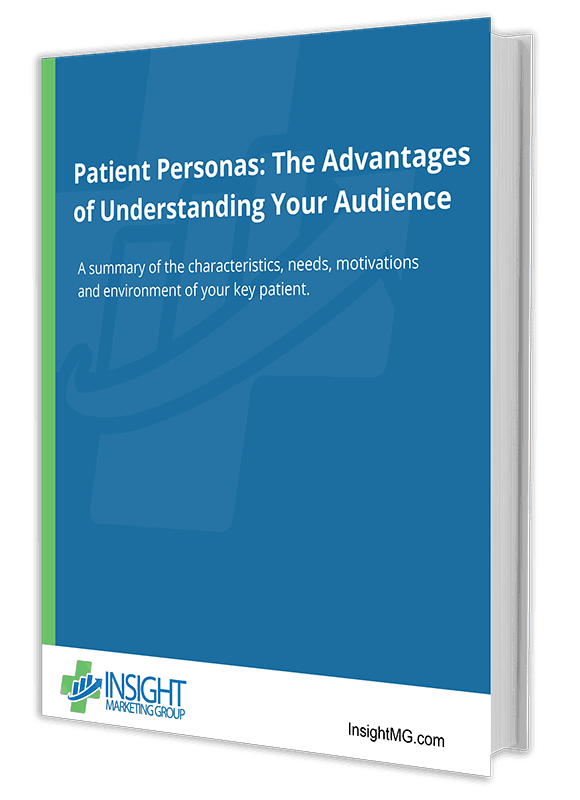 If you are one of the fortunate physicians or medical practice managers that have realized you absolutely need to be on Facebook (since that’s where your patients are), you’re already two steps ahead of your competition. But how can you use a Facebook strategy to boost revenue and keep your competition at bay?
If you are one of the fortunate physicians or medical practice managers that have realized you absolutely need to be on Facebook (since that’s where your patients are), you’re already two steps ahead of your competition. But how can you use a Facebook strategy to boost revenue and keep your competition at bay?
Not only has Facebook become an integral part of marketing your practice, it is now a key customer service channel, meeting patients where they spend much of their time (online) and when they want to be communicated with (which, nowadays, is in real-time).
The power of Facebook can also be felt in the realm of patient reviews and testimonials. More than 75% of patients use online reviews as their primary step in evaluating and choosing a new doctor. Facebook gives healthcare providers a myriad of ways to maximize their existing patients’ success stories in order to drive more traffic through the front door.
And if you haven’t realized the value of Facebook to your medical practice, don’t worry, there’s still hope. However, if you don’t start playing catch-up now, you risk being left behind for good. If you want to be in front of the right patient, at the right time, with the right message your practice needs to be on and IN Facebook for the following reasons:
To build your patient community (through posting content, engaging with your audience, and sharing)
To enhance patient customer service (through messenger, responding in real-time to complaints and praise, and regularly interacting with patients)
To get the most bang for your advertising dollar with Facebook’s highly-targeted ad capabilities
Below we’ll walk you through how to develop a Facebook strategy and things you can do right away to start implementing it.
Facebook Is Not Going Away
With more thanBy now, if you’re not on Facebook, your grandma and all her friends definitely are. What’s more, despite the recent media storm over selling data, the platform is here to stay. Even with many pundits predicting the social platform’s demise in 2015 with the emergence of contenders like Instagram, Twitter, WhatsApp, and Snapchat, Facebook has continued to grow and outshine the rest, almost doubling its monthly user-base since 2012.
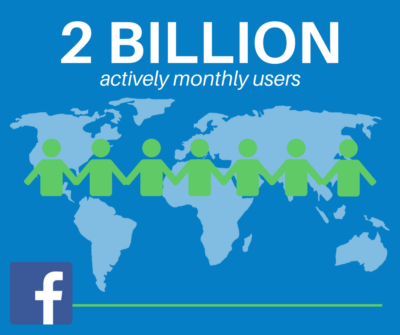
2 billion active monthly users, most of the developed world spends more than a considerable amount of time on the social networking site. Facebook allows users to connect and share with people and brands that they care about. Not only do people share status updates, pictures of their lunch (guilty!), they share reviews and recommendations about businesses they know, love and trust.
Facebook users also gripe (loudly) about businesses with which they’ve had negative experiences. What’s more, those users expect businesses to respond to their questions, concerns, and complaints in real time, making the platform a critical venue for achieving and maintaining high levels of customer service and satisfaction.
In today’s digital marketing world, we know exactly what works and how much it takes to attract and retain that coveted new patient.
Why Facebook Matters
When it comes to identifying potential patients, baby boomers and household decision makers are the target demographic for many medical practices. Interestingly, Facebook’s 2017 Demographics Report revealed that:
- The 55+ demographic exploded with almost 50% growth over the last three years
- 35-54-year olds followed suit at 20% growth
- 31% of all seniors are on Facebook
- Almost 45% of baby boomers use social media for healthcare-related information
Moreover, the Pew Research center reports that approximately 62% of online adults aged 65 and older now use Facebook, and nine out of ten 18 to 29-year-olds, 84% of 30 to 49-year-olds, and 72% of 50 to 64-year-olds use the platform.
When you get right down to it, this means that your ideal patients are on Facebook right now. And their numbers are growing.
According to social media healthcare researchers and experts, if you want to connect with patients and be part of their community, you need to go where the community is. Search Engine Watch reports that 90% of young adults aged 18 to 24 believe medical information posted by peers within their social media circles.
Boost Your Credibility and Interaction with Patients
Facebook provides you with a great venue for sharing an array of knowledge and expertise unique to your practice and skill set. What you share immediately generates a sense of competence, know-how, and authority, and will allow many online users to view, interact, and share the information. A research study by Demi & Cooper Advertising reported that 41% of people affirmed that social media influenced their choice of a specific physician, hospital, or medical practice.
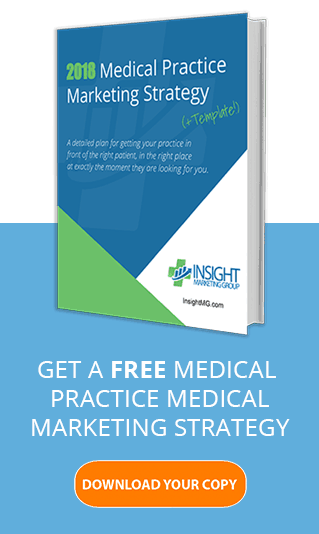
By using Facebook to interact with patients, you can initiate a trust-building dialogue. Posting regularly and keeping your Facebook page up to date will keep your practice more relevant in your patients’ lives, embed you more fully into the online community, and drive more traffic to your website and through the front door.
Some patients may feel uneasy about coming in for an appointment when all they want is an answer to a personal medical question. For others, it can be more comfortable having a question answered through a direct message rather than on the phone or in person.
But there’s much more to the Facebook picture than meets the eye. The platform is now THE place for customer acquisition. Facebook Ads are inexpensive, highly targeted, and provide a great return on investment (ROI). The wealth and breadth of information and data Facebook collects about its users allows the social media channel to offer precisely targeted ads based on lifestyle preferences, interests, places of employment, etc.
By advertising on Google using AdWords, you can target people who are searching for a particular item or service, but on FB you can target based on personal tastes, preferences, habits, and almost any other form of personal segmentation you can think of.
However, as the current maelstrom involving Facebook and Cambridge Analytica has demonstrated, potential violations of data usage can often be innocent and occur when not enough due diligence is performed. The hearings involving Mark Zuckerberg showed that legislators are beginning to tackle the complex areas of cybersecurity, technology, and privacy issues a lot more seriously.
Aside from needing to be on Facebook as a business (for posting, engaging, sharing, and building trust), and for customer service (interacting and responding to patient questions or concern on messenger), Facebook is one of the best and most effective places you can put your practice’s advertising dollars.
Getting Started on Facebook
Everyone talks a lot about needing to be on Facebook, but how do you even get started? If you are brand new to Facebook, if you already have a business page but don’t feel you’re using it to its potential, or if you’re already active on Facebook but could use some additional strategies to succeed, we break it down step-by-step below.
Creating Your Facebook Business Page
The first step in getting your practice on Facebook is, obviously, creating your business page. Facebook allows you to designate multiple page admins meaning your practice manager, marketing team, and even your physicians can all have access to and help manage your business page.
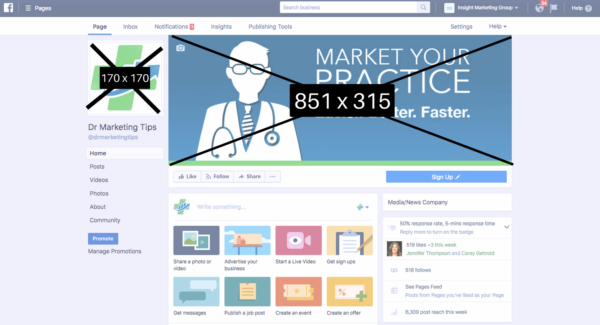
From Facebook Business Manager, you can update your cover photo, profile picture, business information, and even add a call to action. Business Manager offers an avalanche of helpful data and capabilities to reach your current and potential patients better.
Developing a Facebook Strategy
So, you set up your Facebook page, and your Mom is your first fan, now what?
What should you post and how do you get people to care? It’s important to remember that this is social media and your goal should be to make a connection with your audience and community and add a personal touch if possible. Remember: patients are generally a little anxious about coming to see you, and Facebook is the perfect place to show them your office staff and your physician(s) are people too.
Through our extensive experience working with medical practices, we’ve identified 6 types of high-performing content:
 Highlight Community Involvement/Events: The chances are that at some point throughout the year, your medical practice sponsors or participates in community or charity events. In addition to attending and enjoying the event, be sure to grab a photo or video (especially if your physicians are present) to share on social media. We like to say, “If you don’t take a photo, it never happened.”
Highlight Community Involvement/Events: The chances are that at some point throughout the year, your medical practice sponsors or participates in community or charity events. In addition to attending and enjoying the event, be sure to grab a photo or video (especially if your physicians are present) to share on social media. We like to say, “If you don’t take a photo, it never happened.”
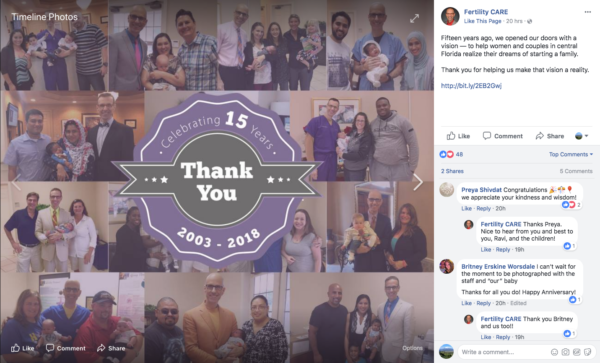 Share Facts About Your Practice: Dig through your practice history and share a little anecdote about your office and your physicians (with pictures, and even video, if possible). Every organization has a story to tell about its inception, creation, challenges faced along the way, and success stories. Remember fans and followers like your page because they like your practice, so they’re probably open to learning interesting facts about you. Stories about your practice will engage your patient community in new and innovative ways.
Share Facts About Your Practice: Dig through your practice history and share a little anecdote about your office and your physicians (with pictures, and even video, if possible). Every organization has a story to tell about its inception, creation, challenges faced along the way, and success stories. Remember fans and followers like your page because they like your practice, so they’re probably open to learning interesting facts about you. Stories about your practice will engage your patient community in new and innovative ways.
Highlight Your Physicians: File this one under “no-brainer.” One of the best posts you can create involves highlighting your physicians. Post a photo of the doc in clinic that day or link back to the physician’s bio page on your website and allow the social media channel to pull their headshot or a video from the page. Consider things such as why they went into medicine, where they went to school, the specialized training they pursued, their favorite hobby, and go-to coffee order. It sounds silly, but posts like that really help to humanize your physicians and can go viral quickly as followers share and comment on the information.
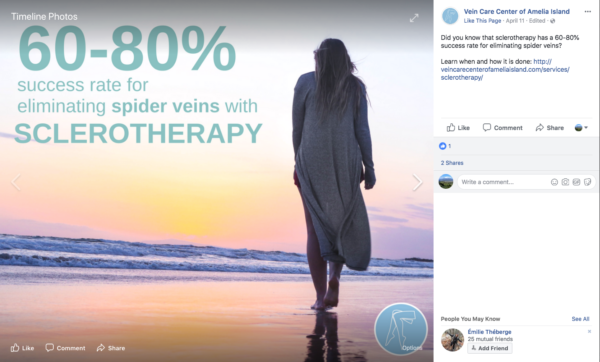 Specialty Facts: Don’t have anything interesting to say about your office? Don’t worry. Representing a medical practice means you’re an expert on something many folks around the community don’t know much about (well, hopefully anyway). Your fans and followers are interested in your office and your specialty, so take this opportunity to educate them. Example: “Did you know the funny bone isn’t actually a bone?”
Specialty Facts: Don’t have anything interesting to say about your office? Don’t worry. Representing a medical practice means you’re an expert on something many folks around the community don’t know much about (well, hopefully anyway). Your fans and followers are interested in your office and your specialty, so take this opportunity to educate them. Example: “Did you know the funny bone isn’t actually a bone?”
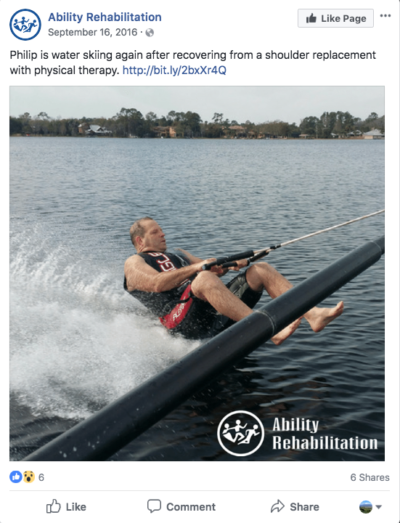 Sharing Patient Testimonials: One of the easiest ways to maintain a personal connection with your community is to highlight the people that keep your doors open: your patients. Most patients will be happy to share photos of themselves (everyone needs their 15 minutes of fame after all), which will put your practice in front of their friends and family, significantly increasing your organic reach.
Sharing Patient Testimonials: One of the easiest ways to maintain a personal connection with your community is to highlight the people that keep your doors open: your patients. Most patients will be happy to share photos of themselves (everyone needs their 15 minutes of fame after all), which will put your practice in front of their friends and family, significantly increasing your organic reach.
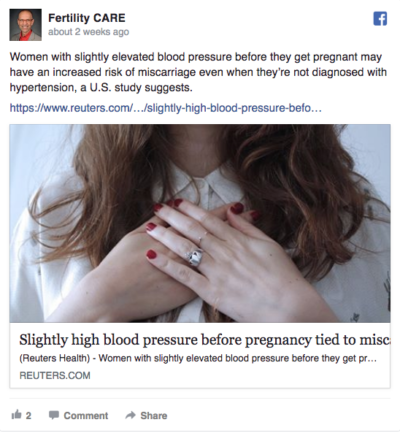 Interesting Articles that Relate to Your Specialty: Sometimes, coming up with original content just takes too much time. This is a good time to share a news article with content relating to your specialty. Add a personal touch with your caption to the content for added engagement.
Interesting Articles that Relate to Your Specialty: Sometimes, coming up with original content just takes too much time. This is a good time to share a news article with content relating to your specialty. Add a personal touch with your caption to the content for added engagement.
According to HootSuite, the best time to post on Facebook is between 12 p.m. and 3 p.m. Monday, Wednesday, Thursday, and Friday, and on Saturday and Sunday between 12 p.m. and 1 p.m. We recommend posting two to three times a week and repeat content every few weeks. Don’t panic if that sounds like a lot. With some quick and efficient planning, you can easily organize your posting schedule on a month to month basis. Facebook’s algorithm allows posts to have a longer shelf life, so you don’t need to post as frequently as you would on Twitter.
Evergreen Content and Automation
Sometimes there isn’t an extra hour (or minute) in the day to plan, create, and post something on your practice’s social media account, right? Luckily, several tools can make that task easier.
By developing evergreen content (content that isn’t dated and could go out at any time and still make sense), can save you hundreds of hours and headaches in your social media strategy.
One of our favorite tools for automating our evergreen content is Meet Edgar. This life-saving application allows you to create a schedule and choose the frequency of which posts go out. Posts are selected at random from the pool of evergreen content to keep our social platforms fresh when we don’t have the time to stop everything and come up with a social post.
Edgar (we’re on a first name basis) is also great because it allows you to categorize your content. Maybe everything isn’t evergreen. Maybe you need a “#MotivationalMonday” category that only goes out on Mondays. Or maybe you need a “Holidays” category where you can schedule your 4th of July, Thanksgiving, and New Year’s post. Edgar is a smart guy, he knows you don’t want your “#MotivationalMonday” post to go out on Tuesday, and he knows you don’t want your “Happy Labor Day!” post to go out in February. That’s why Meet Edgar allows you to select when each post category goes out. Once you set it up, this tool will completely change the game when it comes to your social media strategy – and your sanity.
Using Facebook Ads
Facebook isn’t only about sharing and social media; it’s also one of the largest digital advertising platforms available.
What makes Facebook Advertising so valuable is the extremely detailed targeting it allows business managers to implement. Aside from being a social company, Facebook is a data-driven enterprise, and they are willing to trade you this information for just a few dollars.
Unlike expensive print ads that reach a large number of people that may or may not care about your practice, Facebook Advertising allows you to choose who sees your ads based on things like their location at any given time, age, marital status, likes, behaviors, and hobbies.
Facebook’s continuous algorithm updates give promotional content less and less visibility on the platform. Therefore, investing a small amount of money in promoting personal posts has become indispensable for medical practices to reach out to and engage specific audiences.
It can be challenging for practice managers to target patients in their practice’s geographic vicinity or area of expertise as well as to reach out to other doctors for patient referrals. Although television and radio ads rarely succeed in reaching a practice’s ideal audience, Facebook’s targeting capacities have consistently achieved results for medical advertisers while providing a high return on investment. From specialists to family practitioners, physicians can leverage Facebook to hone in on and reach their preferred and ideal patients.
Facebooks’s elaborate targeting capabilities can identify patients that fit a specific demographic such as patients who recently moved to the neighborhood and are looking for a healthcare provider. Other patient demographics that Facebook tools can help identify are expecting mothers or older adults who typically visit their physicians more frequently. Facebook’s comprehensive targeting can also enable your practice to reach medical practitioners (and their networks) in other specialties that could act as referral sources down the road.
So, what should you do?
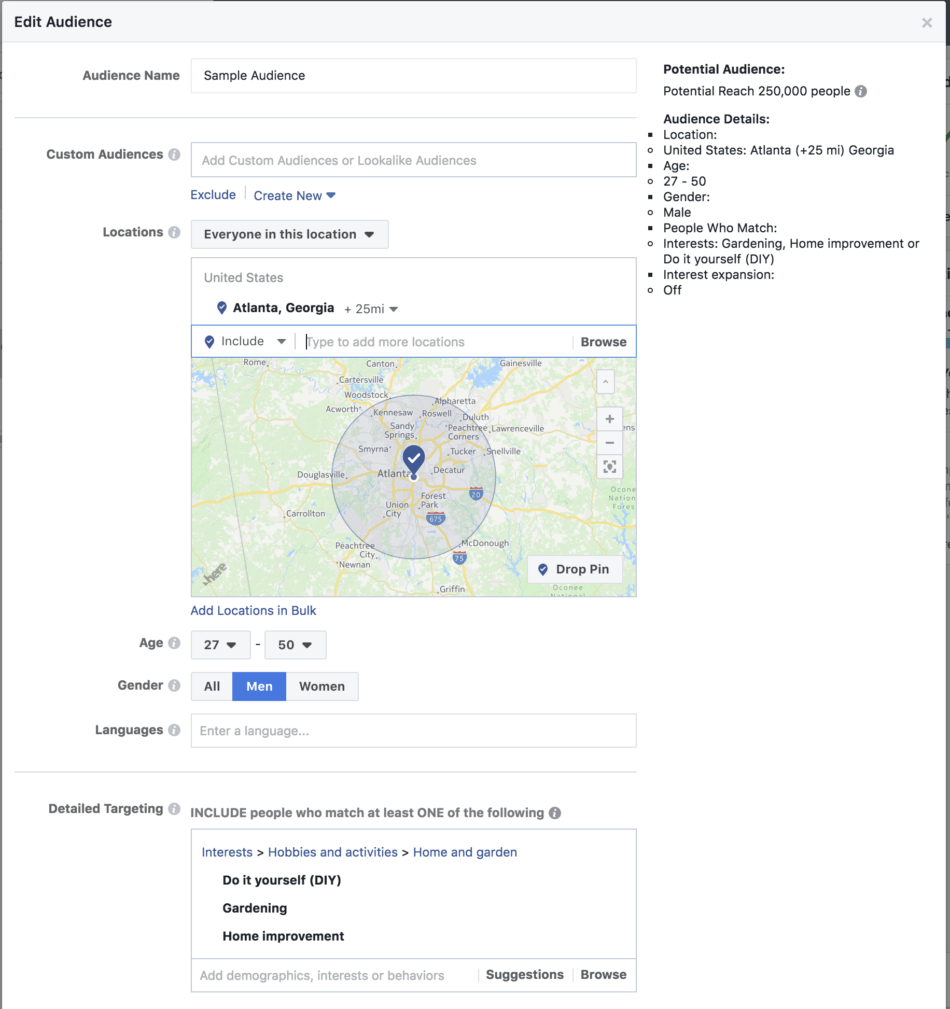 We suggest creating an advertising account and choosing an audience that makes sense for your practice. Here are some quick tips to start and how to go about it:
We suggest creating an advertising account and choosing an audience that makes sense for your practice. Here are some quick tips to start and how to go about it:
- Take a look at your patient demographics
- Put yourself in their shoes
- Use your context clues to determine what activities they like
- Spend $20 a week to get your feet wet
You can run specific ads to your target audience about any service or procedure that you want to drum up interest for. Or post a photo of your staff and “boost” it to your target audience to get more reach and impressions. You’ll be amazed at the results such a small budget and a little planning can achieve.
Other great tools for social media automation include:
The Time Is Now
We know that many doctors can be averse to promoting themselves (especially older physicians). Until 1975, the American Medical Association banned doctors from marketing and advertising in its code of ethics, and the words “medical marketing” still have a negative connotation for some.
However, physicians that do not use digital promotion methods may actually be doing a disservice to potential patients, particularly ones that may be new to the area and are looking for the best care. By default, these prospective patients could fall into the hands of the least preferred doctor who has blazed his/her poster on the side of a building.
Facebook offers medical practices a simple, cost-effective, and impactful way to establish authority, offer patient and customer support, and use targeted ads to reach the ideal patient at the right time with the perfect message. The social media platform is ideal for highlighting patient and practice successes and creating connection and trust with potential patients.
What are you waiting for? Reach out to us today to find out how we can make Facebook work for you.
